Seed onions in one season through seedlings. Planting onions before winter in Siberia. Bow before planting - preparation
Most often onions are grown from onion sets, which can be purchased in stores for gardeners or grown from seeds themselves. Personally, we, with my husband, did not manage to grow a good harvest of onions from a sevka for several years, the onion was small, and the harvest was insignificant. As in the joke "put the bucket and collected the bucket."
We tried and switched to growing onions from seeds through seedlings in one year.
If you decide to try this method of cultivation, decide on the varieties, purchase seeds and forth.
We will need:
- onion seeds
- mini-greenhouses (this is a one-piece tray and a transparent cover)
- cassettes with small cells, approximately the size of each cell is 2.5 x 2.5 cm. There is 40 cells in such a cassette.
- soil mixture for seeds.
All this can be bought at a regular garden store.
Important point: although it is believed that nigella (as the onion seeds are also called) retains its germination without loss for 2 years, but I advise you to use annual seeds (i.e., fresh).
We fill the cassettes with soil mixture almost to the top, if the ground is brought from the street, let it warm up, do not sow the seeds in the cold ground. We put each cassette in the mini-pan tray. And start sowing. I put 2 seeds in each cell, if both sprout, that's okay, they will grow together before transplanting to open ground. Sprinkle seeds on the ground quite a bit. If you prefer to water the seeds from above after planting, then you should not cover the seeds with earth on top, they will fail along with the water to the desired depth. I put the cassettes in pallets filled with water and each cell is soaked from the bottom through the holes of the cassettes, so I sprinkle earth on top. After the earth is saturated with moisture, I drain the water from the pallets and wipe the pallets dry.
An interesting point: if the pan of your mini-greenhouse has no convex reflux, then it is better to put an old plastic grid or grid on the bottom of the pan. This is necessary to create a drainage, onions like water, but avoid stagnation of water.
We close each lid with a pallet and put mini-greenhouses in the warmest and sunniest place to create a "greenhouse effect". I have this sod window south window. You can use a phyto-lamp for lighting if there is no suitable place.
Important point: mini-greenhouses should be in the light for full seed germination. I do not touch 7 days at least. Shoots should appear within 7-14 days. If after 2 weeks there is no germination, the seeds are bad. Throw out, sow fresh.
After seed germination, I remove the covers, it is desirable to rearrange the mini-greenhouses from direct sunlight to another place, otherwise the seedlings will stretch, and the root system will not fully develop by the time of landing in the exhaust gas (open ground). It will be enough table, for example, next to the window sill, you can use the phyto-lamp on cloudy days. If you use a stitch or shelves on the windowsill, put the seedlings on the topmost "floor".
I water regularly in pallets, but not on top, I grow seedlings in the usual mode. I feed with complex liquid fertilizer diluted in water after the 4th week after sowing, i.e. since the end of March, through irrigation.
I do not cut the seedlings and do not add anything to the ground. Last year, I decided to cut some of the onion seedlings for the sake of the experiment, and leave some of them "uncut." According to the theory (it is not known whose!) Trimmed onion seedlings better form the root system. No difference noticed. Both the one and the other onions grew the same.
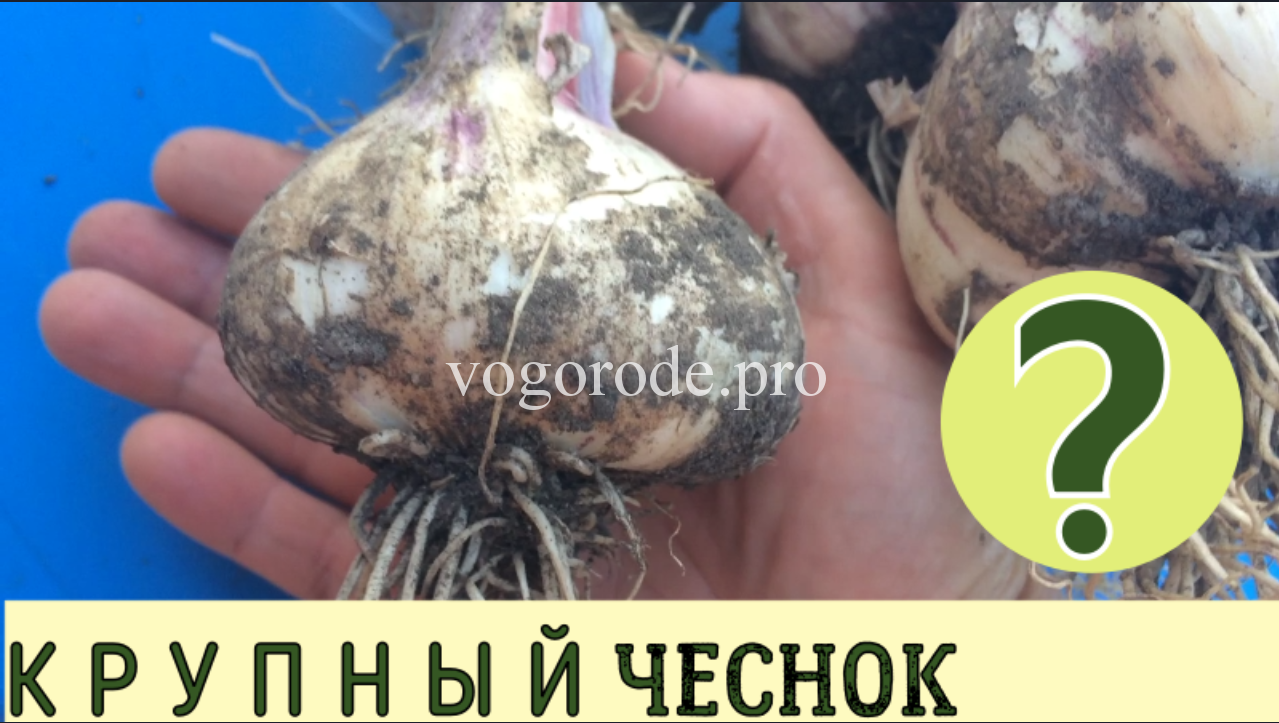
My bow cassettes at the end of March
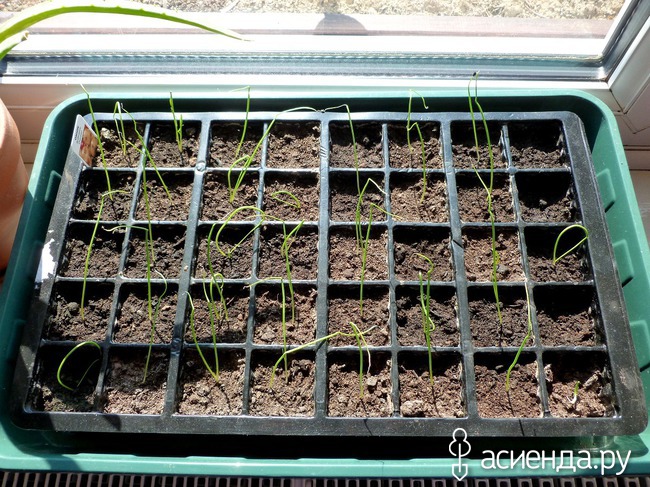
In the first half of May, I would say more precisely after Victory Day, when the threat of recurrent frosts has passed, I plant it in open ground.
Here I want to distract and pay attention to the following:
The onion beds are best done in those areas of your site where cucumbers, cabbage, tomatoes, and potatoes were grown in the previous season — those crops under which we usually apply large doses of organic fertilizers.
In no case can not plant onions on the site, which was occupied by any of the types of onions, because:
- firstly, various pathogenic bacteria and other microorganisms can remain in the ground, as well as those pests that “specialize” in this culture;
- secondly, the soil in these places is already depleted of those nutrients that are necessary for the growth of onion plants.
And onion is not desirable to plant after such plants as: garlic, carrots. At the same place, onions can be planted not earlier than in 3 years, and best of all in 5 years.
In addition, onions do not like to grow on acidic soils, because in this case the plants assimilate food much worse and are more often affected by such a formidable disease as downy mildew (peronospora). Although, this is not the only reason for onion lesion with peronosporosis.
So: planted in open ground. What method?
Using a wooden board or a beam, I move the earth away, making a long hole / trench no more than 3-4 cm deep. I take the seedlings out of the cells with a whole lump (for this purpose, I plant the seeds in separate cells at once) and put it on a prepared treadmill. And from above I cover with the same ground that I pushed aside the board. This method allows you to avoid damage to seedlings (especially its root system) during transplantation. Gently water from a watering can with a spray. Everything. After 2 weeks, all the seedlings take root and get up from the barrel in the "rack".
The most favorable days for planting onions on the Lunar sowing calendar in 2016 are May 19–20, June 15–19, July 13–16, August 10–13, April 25–26, May 23, July 3, July 31, 1 August 27–28.
Video: Planting winter onions and garlic! Preparation of beds
Planting bulb onions on the lunar sowing calendar gardener 2016
In central Russia, in Siberia and the Far East onions are grown through sevok. In the first year, small bulbs are obtained from the seeds — seed sets; in the second year, large bulbs are grown from seed plantations.
In the south of Russia seed onions can be grown in just one year.
Onions are cold-resistant plants: onion seeds can germinate at a temperature of + 1 & hellip- + 2 ° С, but shoots appear most quickly at + 18 & hellip- + 20 ° С. Young onion plants can withstand frosts down to –6 ° С. The optimum temperature is + 20 & hellip- + 25 ° С.
In the Moscow region and in the whole of central Russia Onions in open ground are planted from April 25 to May 5. After planting, the onions are watered and covered with foil or lutrasil. When planting earlier, the bow may shoot. To the onions sprouted and rooted faster, it can be lost in the solutions of growth stimulants. At first, the onion grows slowly: up to a month before the emergence of shoots in adverse conditions, in favorable conditions - 2 weeks.
Landing on the national calendar: onions begin to be planted in open ground, when the leaves begin to unfold on the bird cherry.
In the greenhouse, onions can be planted in early greens at the beginning or middle of April.Onions on a feather can be driven out during the whole season, up to September, planting it in spring and at the end of summer in greenhouses, in summer in open ground. On a green feather it is better to plant a turnip or samples. During growth, the onions are watered on the feathers once every 2-3 days and once fed with a solution of urea (1 tablespoon per 10 liters of water).
Care for planting onions grown on a turnip
Onions should be planted in sunny places, while weeding. During the summer, the onions are weeded up to 5 times, since the onions like loose soil and weed-free soil. When sowing thickened, onions produce a weak crop.
Onion unpretentious in relation to moisture in the soil. At the beginning of growth, water is watered once a week, with the onset of the formation of the bulbs, water is watered once every 4-5 days, and since mid-July watering is completely stopped.
On well-filled soils with autumn compost and mineral fertilizers, top dressing is not needed. If plants grow poorly, you can feed a solution of mullein (1:10). The second dressing can be carried out 20 days after the first with the addition of phosphorus-potassium fertilizers and the third phosphorus-potassium fertilizers, at the moment of the active formation of the bulbs.
Usually the bow ripens by early August. When the onion leaves begin to fall down, and the dry scales acquire a characteristic color for the variety, it is time to start harvesting.
Video: Lunar calendar. Landing ONION ON PEN. April 2016
Planting shallots on the Lunar Sowing Calendar 2016
Shallots are grown from seeds or bulbs: seeds are sown in the ground in autumn, bulbs - in spring.
In the middle lane and in the northern regions of Russia, the bulbs are planted in the spring in late April - early May. In the southern areas of the bulbs, as a rule, planted in the fall, in late October. Depth of landing - 4-6 cm.
Care for planting shallots standard: watering, weeding. At one place can grow up to 5 years.
Read more: Shallot varieties
Favorable days for planting onions and caring for them according to the lunar sowing calendar 2016:
planting onions May 19–20 — June 15–19 — July 13–16 — August 10–13 — still can be April 25–26, May 23- July 3, July 31–1, August 27–28
forcing on a feather January 14–27, 1, 2, 5–6, 13–14, February 22–24, 11–13, March 24, April 8–9
watering on any day except 15–16, 25–26 February – 14–15, 23 and 24, with caution - 9 March – 10–11 and 19–21 April, 1–2, 7–8, 16–18, 29 –30 May – 4–5, 13–14, 25–26 June – 1–2, 22–23, 28–29 July – 6–8, 18–19, 25–26 August.
introduction of complex feeding 4, 5–7, 8–10, 14, 22–24 February – 1–4, 6, 28–31 March – 1, 6, 24–30 April – 3–5, 22–26, 31 May – 4– 5, 23–24, 27–28 June –– 3–4, 20–21 July – 1, 2, 4, 21–31 August.
Particularly positive impact will fertilizing, held June 29–30– July 26–27 – August 23–24 top dressing with dry fertilizer15–16, 25–26 February – 14–15 March – 10–11 April – 7–8 May – 1–2, 28–30 July – 25–26 August.
Learn more about how to grow plants, you canfrom other articles of our site. Please also pay attention to the information block to the left of the text. Links located in it lead to articles related subjects.
In order to get a gorgeous harvest of large turnip onions, it is necessary to plant it by means of a set of bows on average 1.5-3 cm.
Before you start planting, onions need to carefully sort out and weed out all substandard onions, and what remains to be sorted by parameters, so that the shoots were as even as possible. Initially, large bulbs are planted, then medium sized bulbs, and only then the smallest ones.
If you have onion sets from the previous harvest, which was stored at an average temperature of 18-20 degrees, then you should not warm it, but if you already buy onions for planting, it is better to warm it 2-3 days before sowing at a temperature of 30 degrees -35 using heaters. After warming, the onions for sowing, wrapped in a cloth bag, should be lowered into the solution (for 10 liters of water for 1 tbsp of a complex fertilizer) for 10-14 hours. Then place the seed in a solution of copper sulphate for 10 minutes (1 h. Spoon for 10 l. Of water).
But there is another way to process onions before sowing: pour the seed into the bucket and pour it literally for a couple of minutes with water at a temperature of 70 degrees, and then lower it for about 1-2 minutes into cold water. This procedure is carried out just before sowing.
Planting onion turnips produced in a previously prepared garden bed, which is cleared of all kinds of weeds and properly fertilized with organic and mineral substances. On the ridge make small grooves in depth, see 4 and distance, see. 15 between each other.
Landing, as a rule, produced in late September - early October. Before the frosts, it is necessary to warm sevok from freezing, and accordingly death, for this purpose, the ridge is warmed with sawdust in a layer of cm 5. In the spring, sawdust is removed. In winter, you need to make sure that the bow ridges are not abundantly filled with water, as sevok can rot. The turnip can also be planted in the spring, but only the “winter bow” is distinguished by the greatest stamina and yield.
OgorodSadovod.com
We plant onions in the spring: terms, technology, leaving
Most gardeners who grow onions in their own area eat mostly green leek. And only a few of them grow onions on a turnip, which can be stored for quite a long time. For these purposes, the onion is planted in the spring. Observance of simple rules will allow to collect a guaranteed, large and high-quality harvest.
Landing dates
Place for landing is prepared in the fall. They dig up the soil deeply and fertilize it abundantly with compost, manure or chicken manure, at the rate of 1.5–2 buckets of organic matter per square meter. Also, 25–35 g of superphosphate and potassium salts are applied per square meter. Good, large heads can be harvested from the area where pumpkins, zucchini, peas, tomatoes or potatoes have previously grown. If, however, planted sevok spring in the area after carrots, beet, cucumbers or garlic, then the heads will develop very slowly and the harvest will decrease.
Onions are planted in spring as soon as stable, warm weather is established and the soil warms up well. Since in insufficiently heated soil, below 12-14 ° C, the onion will go to the arrow. As a rule, the time for landing is chosen at the end of April - the first days of May. Delay in sowing has a negative effect on the harvest, because of the high temperatures and lack of moisture, the bulbs develop much more slowly. Many gardeners with extensive experience are guided by the term of planting in the spring at the beginning of the flowering of bird cherry.
Landing technology
Immediately before planting, well-dug-up beds are watered with a dark pink solution of potassium permanganate. In the future, until the end of the harvest, they no longer apply any fertilizers, but only monitor the cleanliness of planting, timely removing all weed vegetation.
Seed preparation
If onions are grown on a feather, they are planted with seeds. 25-28 days before they are sown in the beds, they are tested for germination - stratification. Then they are transferred to gauze and placed in hot water of 45-55 ° C for 12-16 minutes and immediately dipped for 1.5-2 minutes into cold water, carrying out the so-called hardening. After that, the seed is kept for 22-26 hours in a cloth moistened with warm water, preventing it from drying out. Next, the seeds are soaked for 2-3 days, changing water daily, and placed on the lower tier of the refrigerator, or in another cool place. At the same time they swell and get rid of inhibiting the germination of substances. Before planting, they are mixed with sawdust or sand.
Seed preparation
If you are planting onion seedlings in the spring on a turnip, then pick out the bulbs and sort by size. As a rule, planted in the first place large, then medium and small. It should be noted that large bulbs will go to the arrow, from small ones grow large heads. 3-4 days before planting, the sorted planting material is dried and heated, spreading it in a thin layer at the heat source, not more than 35-42 ° C. Without warming up and drying the whole onion will go to the arrows. After that, they are soaked for 8-10 hours in a weak solution of complex fertilizers, 15-20 g per 10 liters of water. Next, placed in a solution (10-15 g per 10 l) of copper sulfate for the prevention of fungal diseases. Then washed and planted. To obtain a feather before planting at the bulb is cut off the tip.
Landing
Both seeds and sevka are planted in spring in prepared, well loosened beds. Seeds are planted according to the scheme with the distance between the beds of 12-18 cm, between the onions 1.5-2 cm, and buried to a depth of 1.8-2 cm. After that, the soil is watered and mulched with straw, sawdust or covered with a dark film to prevent its drying out.
Sevok is planted in the beds at a distance of 25-28 cm, between bulbs 10-12 cm. It is buried to a depth of 4.5-5 cm, so that 2.5-3.5 cm of soil is above the shoulders of the bulbs. After that, the beds are watered and mulched.
![]()
Bow care
The lack of moisture in the spring is especially noticeable on the leek, the feather gets a bluish, white shade, and the tips dry out and bend. With an excess of moisture or a lack of light, the feather becomes more pale and thin. Therefore, moderate watering is important. After planting, in May-June, the beds are watered no more than 1-2 times a week, spending 7-11 liters of water per 1 sq. M. Then, watering is reduced to 1 time in 1.5-2.5 weeks, as the head is aging bulbs. However, in case of severe drought, in order to prevent wilting, the number of waterings is increased, while reducing water consumption. Regular loosening of the beds, at least once every 2-2.5 weeks, will allow not only to keep the planting clean, but also improves the air-wet mode, preventing the ground from over-compacting.
If the growth of feathers occurs slowly, add additional fertilizer to stimulate growth, 250-280 g of bird droppings or mullein per bucket of water, 15-20 g of urea. Spend this solution at the rate of 3-3.5 liters per square meter. After 12-16 days, the dressing is repeated. When the onion feather reaches 12-16 cm, they carry out preventive treatment for fungal diseases, for which the beds are sprayed with a solution of copper sulfate and liquid soap, 5-8 g per 10 l of water.
Onions are harvested from the second or third week of August to September, when the feather has fallen and the formation of new feathers has stopped, and the heads have acquired a characteristic color and have formed. If you delay in harvesting, the head will resume growth and the bow will not be suitable for storage.
Video "Preparation of onion sting for planting"
In the video a brief overview of some varieties of onions. Shows the process of preparing onion seeding for planting - the selection of bulbs, processing, disinfection.
plodovie.ru
Growing onions
General culture information
Onion bulb is a well-known plant originally from Afghanistan. Man began to cultivate onions a long time ago, more than four thousand years ago. Currently there are about 400 varieties of this plant. More than 220 species of onions are grown on the territory of our country. The most common are the varieties that give leaves and bulbs.
Onions are a two-year-old plant, which in the first year of life produces an onion, and the next season - seeds. Agrotechnology involves reproduction as seeds and bulbs (vegetatively).
The structure of the bow.
This highly respected vegetable is a source of vitamins B, C, calcium, copper, manganese, zinc, fluorine, iron, iodine, molybdenum and essential oils. Onions increase appetite and help improve digestion. Also, this plant is used in folk medicine in the treatment of many diseases.
Onions are monocotyledons. Onion seeds are small, 1 g contains 200 ... 300 pieces. They are black, fairly solid shell. When embedded in the soil, seed germination occurs on the 15th ... 20th day.
Onion leaves are tubular, well adapted to low moisture content and arid climate.
On the plant every 4 ... 7 days a new leaf is formed. Onion root system is fibrous.
Onion growing conditions
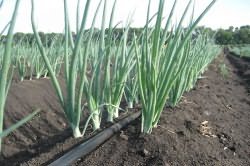
For better development and growth of the plant, infrequent watering is necessary during the growing season.
Onions are cold-resistant plants, the optimum temperature for growth is considered to be 12 ... 16 oC. Seed germination occurs at a soil temperature of 3 ... 5 oC. Due to the fact that the bulbs have a surface location, they easily tolerate frosts up to 5 ... 7 ° C. Sharp onion varieties are considered more resistant to low temperatures. Sweet and salad varieties can die when the temperature drops to - 3 ... 4 ° C. To improve the development of plants recommended infrequent watering during the growing season. Subsequently, for ripening bulbs, watering should be stopped. Such agricultural technology will allow you to get a good harvest.
Agricultural technology of onion cultivation prescribes good lighting for the plant. Onions bear fruit better on weakly alkaline or neutral soils. On acidic soils, it gives small yields.
The most common varieties of onions are Pogarsky, Kaba, Krasnodar G-35, Danilovsky, Rostovsky onion, Strigunovsky, Mstersky, Arzamas, Lugansky.
Selection of planting site and soil preparation
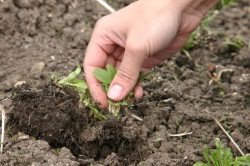
The presence of weeds, in the early growing season, adversely affects the future harvest of onions.
Onions are a very demanding crop for soil preparation and fertility. The bed on which the onion is to be sown should be thoroughly cleaned of weeds. In the early growing season, the presence of weeds adversely affects the future harvest.
The most optimal place for planting onions are high parts of the site, early freed from snow and melt water. The soil should be light in texture, rich in nutrients.
Potatoes or cucumbers that have been fertilized with manure are considered a good precursor for onion sowing. It should be borne in mind that the crop, which is the forerunner of onions, should be cleaned early to enable autumn tillage.
The introduction of fresh manure also adversely affects the quality and abundance of the crop, the onions can hurt and not mature in time. In addition, with the introduction of fresh manure, the soil is very heavily clogged with seeds of harmful plants, which are difficult to dispose of. For high yields, humus is well suited, which is introduced in an amount of 2 ... 5 kg / m2.
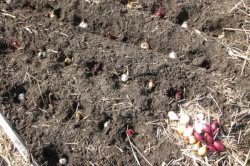
Growing onions with a sev is one of the most reliable ways to get a quality and high yield.
The onion responds well to the application of mineral fertilizers. Agrotechnical cultivation recommends making ammonium nitrate and potash salt at 10 ... 15 g / m2, as well as superphosphate - 20 ... 30 g / m2. The amount of fertilizer is applied based on the active substance.
By preparing the site for planting onion should begin immediately after harvesting the culture of the predecessor. It is best to loosen the soil to a depth of 6 cm, which provokes the growth of weeds. After some time (not later than mid-September), superphosphate should be applied and the bed should be digged to a depth of 15 ... 25 cm. It will not be superfluous to make grooves for the outflow of melt water in spring along the contour of the bed. In this state, the prepared plot is left for the winter. As soon as the weather permits, you should scatter the humus and once again dig up the bed. At the same time, nitrogen and potash fertilizers are applied.
Agrotechnology for onion production involves different methods: planting seeds or planting seed.
Cultivation of onions using sevka
Agrotechnics of onion cultivation from seedlings (two-year method) is the most reliable way to get a high yield of a quality product. For this method, the most suitable are the varieties: Arzamas, Danilovsky 301, Mstersky, Vishensky, Rostov, Strigunovsky, Belozersky, Pogarsky.
Sevok is small onions having a diameter of 0.5 ... 3 cm, which are grown from seeds. It is necessary to start planting sevka at the end of March - beginning of April. The advantage of this method of growing onions is that you can get the shoots in any weather. The vegetation period is 80 ... 90 days. Observing the technology of cultivation, it is possible to achieve significant yields - 30 ... 50 kg of onions with 10 square meters. m on irrigated areas and up to 25 kg - on Bogar.
The future harvest is greatly influenced not only by the seed, but also by the time of planting. Too early sowing periods and a long spring with low temperatures can affect the occurrence of bow shooting. Strelkovanie significantly reduces the yield and quality of the finished product and does not allow to grow a good crop.
During the growing season it is necessary to remove weeds from the beds and loosening the row spacing. This procedure allows you to better preserve the soil moisture, conducted aeration of the soil, which enhances the growth of the onion root system. It is recommended to loosen the aisles to a depth of 5 ... 6 cm. For such a procedure, manual cultivators, hoes or hoes are used.
At the end of the growing season, when there is a partial lodging of the leaves, it is better to remove the soil from the grown bulbs so that they are blown out with air and illuminated by the sun. Such agricultural technology affects the safety of onions in the winter.
Growing onions using seeds
For spring planting of onion seeds (annual varieties), it is first necessary to calibrate the seeds, select the most complete and large ones. It will not be superfluous to soak the seeds in potassium permanganate or in methylene blue solution for disinfection before sowing. Soaked seeds should be placed in a room with a temperature of 20 ... 23 degrees. After swelling, the seeds are scattered on the fabric in a thin layer and covered with sackcloth on top before pecking.
Before sowing, they must be slightly dried. For a uniform sowing of seeds in previously made furrows they can be mixed with dry sand. It is necessary to sow to a depth of 2 ... 3 cm.
During onion growth, it is necessary to carefully remove weeds, loosen the soil every 10 ... 14 days. Onions are particularly demanding of moisture in the initial period of growth, therefore it is necessary to water it moderately every 10 days. At emergence of shoots it is required to make thinning, leaving the distance between plants of 10 ... 12 cm. Further care for onion crops is the same as when grown from planting.
Harvested onions stored in dry cool rooms.
ParnikiTeplicy.ru
Planting onions | Grow a garden!
Planting onion Sevka
My video tells in detail how to plant a bow correctly. You can also read and watch the video on my blog http://elenka2012.com/domashnee-hozya…
Onion is a biennial plant. During the first year he develops an onion. In the second year, a flowering plant is formed from a bulb, which produces seeds. The bulb is very well stored. It can be used not only immediately after harvesting, but also five to eight months after harvest.
The cultivation of onions is carried out in three ways. It may be an annual culture. When from the seed or seedlings in the first year grows food onions. If we are talking about a two- and three-year culture, then for the first year, thanks to thickened sowing, we get onion sets. Further, it is used as planting material. And the third way is vegetative reproduction. A turnip is grown from year to year. Bypassing the seed reproduction. For the cultivation of onion in the conditions of non-chernozem strip all of these methods are suitable. Onions can be grown from seed or from selection. Suitable varieties Bessonovsky local, Danilovsky, Rostov local bulb, Strigunovsky local.
For the vegetative method suitable local Kirov, Pskov and Novgorod regions.
Relatively early maturing varieties are suitable for one-year cultivation - the Vishensky local, the Bessonovsky local and the Strigunovsky local.
Growing onion from seeds
Seeds are black and triangular. Swelling is slow. Under favorable conditions, seedlings appear in seven to ten days. Initially, the seedlings have the form of a loop, after the loop is straightened, real leaves begin to grow. Germination of seedlings occurs slowly. It should be borne in mind that the root system is underdeveloped. Therefore, it is especially important to get rid of weeds in a timely manner and loosen the soil. This will help the growth and development of plants.
Growing onions and caring for them
Rules for growing onions and care for them are the same for all species. Because of the underdeveloped root system, it is necessary to allocate for it fertile, well-moistened, non-acidic and low-soil soils. The best precursors are rye, tomato, cucumber and early cabbage. Manure is placed under them, which is very good. After harvesting the predecessors, it is necessary to immediately carry out the peeling, and then the autumn plowing. Harrowing is carried out in the spring, and before planting or seeding - cultivation with simultaneous harrowing. Mineral fertilizers must be selected depending on the soil.
If you want to get an early harvest, you should grow a vegetable in the beds, which are well warmed. And, therefore, all work related to its cultivation can be carried out earlier.
After seven - ten days from the moment of emergence of shoots spend the first feeding. Twenty-five to thirty days after it, spend the second.
Watering Onions
Watering onions should be made as needed. If the weather is hot, then watering is necessary a couple of times a week. If the weather is rainy, then the vegetables can easily do without additional watering.
Diseases of bulb onions: prevention and treatment
Onions are subject to a large number of diseases. The most common among them are onion smut, mosaic, cervical gray rot, downy mildew (peronosporosis), as well as Donets rot. You should know that if the vegetables were affected by cervical or bone rot and peronosporosis, they are not suitable for long-term storage.
There are a number of measures that help prevent the development of diseases. In particular, this is the observance of crop rotation and annual fruit change. It is necessary to thoroughly destroy all the remnants of the precursors, decontaminate the seeds, observe the spatial isolation between the crops of the first and second year vegetable.
Sow onions in the same place only after three or four years. It is necessary to keep clean planting and food material. Disinfecting storage and prophylactic spraying.
Do not plant near large floodplains, reservoirs or marshes.
The autumn deep plowing with a plow, as well as the introduction of optimal doses of fertilizers will help reduce the risk of onion diseases. However, excessive use of nitrogen should be avoided.
Phosphorus-potassium fertilizers increase resistance to various diseases. In particular, to neck rot and to perinospora. In addition, they will accelerate the ripening of onions and seeds, protect against dangerous pests.
Only healthy vegetables should be used for planting. And warm up the planting material. Onion sets should be heated before planting, and uterine bulbs should be heated before storage. These measures help protect them from neck rot. As a result, waste during storage will be reduced. And also this method will allow time to notice infected bulbs and reject them. Still warming protects against pathogens of powdery mildew.
Business on growing onions
The demand for healthy and tasty fresh greens has always been. And today, many understand that you can create a good business on growing onions. There are several reasons to start doing this. Lesson is quite simple. Planting material is cheap, and there will always be buyers for the harvest. If there is already a land plot, then only fertilizers and planting material will be needed. So starting capital is minimal. You can buy at wholesale bases or in the shops "garden and garden". It remains only to choose - which types you want to produce. In addition, it is not only summer earnings. It is necessary to build a small greenhouse and you can earn money on fresh greens and in winter.
When growing onions from seeds, by the end of the first year they receive small onion - seedlings, which are planted in the spring and at the end of the season receive normal onion bulbs. If they are planted in the third year, flowering shoots will appear, the seeds will ripen and the whole onion growing cycle can be repeated. Usually gardeners prefer to grow onions from sevka, because to keep it until spring at home is difficult, but you can plant it before winter on prepared and fertilized beds. ( discussion of the features of growing vegetables)
| Shine | Onion photophilous, prefers open, dry, sunny beds. |
| Ph soil acidity | Onions grow well on rich loamy soils organic matterwith a pH of 6.4-7.9. Sour soil need chaff. |
| Watering onions | With a lack of moisture onion feather gets a bluish-white shade, its tip is bent. With an excess of moisture, the feather becomes pale green. After planting a sevka, it is watered once a week in May-June (5-10 liters per 1 m²), in July watering is reduced, because bulbs are ripening, but if drought, watering is permissible to prevent wilting. |
| Preparing for landing | Seed preparation for sowing: 30 days before sowing their seeds check for germination. Then put in cheesecloth and placed for 15 minutes in hot (45-50 ° C) and for 1 minute in cold water. After that, the seeds are kept in a cloth dipped in warm water for 24 hours. Then in water at room temperature for 48 hours. Seed preparation for planting: onions sorted out, sorted by size (for uniformity of shoots). In the first place planted large, then medium, and finally, small bulbs sevka. 3 days before planting, the planting material is heated by a heating battery (at a temperature of 30-40 ° C); if the planting was kept at room temperature at home, it is not necessary to warm it up. Without warming the bow sevok will go to the arrow. Then the bulbs are soaked for 10 hours in a solution of any complex fertilizers (1 tablespoon per 10 liters of water). Then the bulbs are placed for 10 minutes in a solution of copper sulfate (1 teaspoon per 10 liters of water) to prevent fungal diseases, then they are washed and planted. If sevok will be grown to get a feather, before planting you need to cut off the top of the onion, and if sevok planted to obtain a full-fledged onion - do not cut anything. |
| Fertilizers | Fertilizers are applied for autumn digging (per 1 m²): 3 kg organics (compost, humus), 1 tablespoon of superphosphate, nitrophosphate, woody ashes. In the spring, the prepared bed is leveled, they are shed with a solution of copper sulphate (1 tablespoon per 10 liters of water), the liquid consumption is 2 liters per 1 m², and the bed is covered with black film for 2-3 days. If the growth of leaves is slow, onions can be fed: for 10 liters of water 1 cup of mullein or bird droppings, 1 tablespoon of urea. Solution consumption - 3 liters per 1 m². After 15 days feeding can be repeated. The third dressing is carried out when the bulbs are the size of a walnut. |
| Good predecessors | Good precursors for siderats, tomato, cabbage, beans, peas. |
| Bad predecessors | Predecessors can not be onions, garlic, cucumber, carrots |
| Planting onions | Sevok planted in the first decade of May. If the soil is cold (below +12 ° C), the onion will go to the arrow. Delay in planting leads to the slow development of the bulbs due to lack of moisture and high temperatures. For the North-West, the flowering of a bird cherry serves as a signal for planting onions. |
| Onion planting scheme | Onion seeds are planted according to the scheme: 15x1.5 cm. After sowing the seeds, the soil is watered with 3-3 liters per 1 m² and covered with a film to dry the soil. Seeding plan: 25x10 cm. |
| Landing depth | Onion seeds close up to a depth of 2 cm. Sevok planted to a depth of 4 cm (so that over the shoulders of the bulb was 2-2.5 cm of soil). |
| Problems | When the onion feather reaches a height of 15 cm treatment against fungal diseases: In 10 liters of water, dilute 1 teaspoon of copper sulfate and 1 tablespoon of liquid soap. Spray the leaves with a solution (0.5 L per 1 m²). Diseases and pests of onions: neck rot, downy mildew, onion rust, black mold, fusarium, stem nematode, onion fly. Many plants in joint plantings are able to take care of their neighbors and to protect their. |
| Care | The care of onions lies in timely watering, weeding. Garden beds are loosened every 2 weeks to a depth of 3 cm. |
| Onion varieties | Varieties of bulb onion: Bessonovsky, Danilovsky 301, Carmen, Odintsovo, Heberna, Shetana. |
| Harvesting onions | The onion is ready for harvesting when the formation of new feathers has ceased, when the feather has fallen, and the bulbs have formed and acquired a characteristic coloring. Onions are harvested from mid-August to the first decade of September. If the harvest is late, the onions will resume growth and become unsuitable for storage. Dug out the bulbs immediately after cleaning, you need to wash, clean the husk and feather, cut off the roots and spread out the bulbs in one layer in a ventilated room. After 2-3 weeks, new golden scales will appear on the bare bulbs, and it can be removed for storage. At the same time, bulbs with a thick, uncovered neck should be used immediately. This method of harvesting in rainy weather is especially effective. |
It would seem that what could be simpler than growing up a useful, beautiful onion on your garden plot, or just on a windowsill? But it turns out that to get a decent harvest, planting and caring for onions should be correct.
In order to get a large head-turnip, it is best to plant onion sets. These are small torches, 1.5-2 cm in diameter. Of course, onions can be grown from seeds. To do this, onion seeds are planted the first year, receiving onion sets in the form of a crop. And in the second year, they planted sevok. But, unfortunately, it is very difficult to store onion sets at home. This requires strict adherence to temperature and humidity conditions. That is why it is preferable to grow a turnip from small bulbs - seedlings.
Before planting onions sets, sort out, removing rotten, dried onions. If you want to get a good harvest, do not be lazy before you plant the onions on a turnip, treat the planting material as follows:
- 1 tablespoon of complex fertilizer dilute in 10 liters of water
- tied bulbs tie in a rag bag
- lower the bag of bulbs into a container with well-dissolved fertilizer
- leave the onion sets in the solution overnight
- in the morning you need to drain the solution and fill the bulbs with a new solution: 1 teaspoon of copper sulfate to 10 liters of water
- soak the bulbs in the solution of copper sulfate for 10 minutes
- rinse planting material in running water
This treatment ensures long-term protection of onions from fungal diseases and rotting.
The soil for planting onion seedlings must be loamy, rich in mineral fertilizers. Landing place is best to choose sunny and dry. But we should not forget that the onion sets loves water, and therefore it needs to be watered regularly - once a week.
vyrastisad.ru
Growing onion seedlings in open field: planting and care - Onwomen.ru
It is difficult to imagine a modern kitchen without a tearful and sharp onion. This vegetable complements many dishes and gives them an interesting shade, besides, it is incredibly useful and protects our body from various diseases. There are a huge variety of onions, there are burning and tear varieties, there are more tender and soft ones, here you should start from taste preferences.
The most common and easy to grow species is onions. Usually it is grown from onion sets, which is sold in gardening stores, or grown independently from seeds. However, the latter option is very time consuming, and it is better to stop at the purchase of planting material.
Preparing for landing
If you purchased onion sets in the store, then you should immediately dry it in a warm place, spreading it out in a thin layer. It is not recommended to use a battery for this, as the temperature around it is usually higher than optimal. If the sevke has already been procured and at the same time it was stored at a temperature not higher than 18 ° C, then it must also be heated to activate the growth processes.
Seeding is heated in several stages; first, it is stored at 15 ºС for 15–20 days, after which the temperature should be raised to 30–40 ºС for 9–10 hours, but not more. Such a procedure is very important for activating growth, as well as for preventing the formation of arrows. When warming up, it is important not to allow the temperature to rise, since this may adversely affect its condition. If you have missed the moment of gradual warming of the heating, then before planting it should be filled with hot water at about 50 ºС, held for 10-12 minutes and cooled in cold water.
Sevka responds very well to treatment with a stimulating drug, such as Zircon or Humisol, which accelerates its growth. Onions can also be placed for 6 hours in a solution with mineral fertilizers of a general type.
And finally, the very last stage is disinfection of onion in a solution of copper sulfate. Preparing such a solution in proportion to 10 liters of water 1 teaspoon of the substance.
How to plant onions turnip from sevka
Sevok should be planted in a previously prepared soil, when the last cold falls - from late April to early May. First of all, it is necessary to plant small-sized sevok, as it does not give shooters even with a cool long spring. Then you need to start the landing of medium and large. Too delay in planting is not recommended, otherwise late crops will not have time to develop large roots, which significantly reduces the yield.
Planted sevka rows with a distance of 8-10 cm from each other, the distance between the rows of not more than 4 cm. If you plant small-varieties, it is better to arrange the bow more closely. Crop depth is 3-4 cm.
After planting, onions should be cared for by loosening, weeding, watering and feeding. In the first phase of the growing season, it is very important to regularly loosen the spacing between the rows, tear up the weeds to create conditions for the growth of strong onions and the active growth of healthy leaves. If sevok grows slowly, you need to perform a comprehensive feeding.
According to the experience of gardeners, in the first 15 days after germination, the plant actively reacts to organic top dressing. To do this, use bird droppings or mullein at the rate of 1:12. Ammonium nitrate can be added to the resulting solution: 30 g per medium bucket. The fertilizer consumes 10 liters for every 10 meters of the row in length. The following dressings are carried out at the beginning of the onion formation phase. 10 liters of water will require: potassium chloride - 10 g, superphosphate - 30 g, garden mixture - 50 g.
Often with heavy rains, the onions diminish with the growing season, the leaves still keep green and do not fall. It is recommended to trim the rhizomes of the plant 12 days before the cleaning procedure. Pruning is carried out no more than 8 cm below the bulbous Donets, thus it is possible to stimulate the active ripening of the onions and the death of the leaves. During any phase of cultivation of onion seedlings in the open field, the bulbs should not be allowed to fall asleep in the soil, as this may weaken the crops and reduce the yield.
Onions can be pulled out of the ground and laid to dry when all the leaves begin to fall to the ground. When they dry, the leaves should be cut, leaving a small part of 4 cm. If the weather is too wet and rainy, then the onions should be dried in a dry ventilated room or under a wide canopy. Also, the turnip can be dried at home in wicker bags or spacious baskets at medium temperatures. However, the risk of spoilage of onions increases significantly when stored in baskets due to the possibility of drying.
Optimum conditions for growing onions from seedlings
Onions are considered quite demanding plants to the quality of the earth. Especially important for him is the level of acidity of the soil. For sowing turnips, you should choose a light or medium loamy soil, fertile and possessing an intensive arable layer. It should be remembered that the level of the soil solution should be moderate, since high acidity negatively affects the condition of the onions and reduces the yield. Unsuitable for growing turnip saline, heavy, acidic and excessively clay soils.
If onions appear arrows, then you should get rid of them. We should not forget about the regular loosening, which is carried out after fertilization and weeding. According to agronomists, onions very favorably react to loosening, especially in the first phase of growth.
Onions - this is a moisture-loving culture that does not tolerate the absence of moisture in the very first period of the formation of leaves and bulbs. It is very important to determine the correct irrigation regime for the turnip. In the initial period, the level of soil moisture should be 80%. If the plant lacks moisture, the leaves grow more slowly, the bulbs are much smaller than the usual size and yield is reduced. When the leaves are already formed, increased humidity on the contrary can cause too active leaf growth, which weakens the bulb and the plant. So when watering it is necessary to take into account the onion growth phase. After the bulbs are fully formed, and no more than a month will remain before harvesting, watering stops completely.
Onions are distinguished by their resistance to cold, but here it is also necessary to make adjustments for its growth phases and, accordingly, different needs. Only ripe onions are sensitive to low temperatures and negatively tolerate frosts. When full-fledged leaves are formed, the turnip becomes more resistant to cold and can cope even with slight frosts down to -3 ° C. An adult plant also favorably tolerates slight cold snaps.
Onions give a high-quality harvest only with good illumination of crops, for it should choose open areas, which fall bright sunlight. Onions are a cultural unit of a long light day, as an increase in the length of the day contributes to the ripening of a strong large onion. However, this factor is not the main thing when growing a healthy plant.
Growing onion seedlings is the most popular and affordable way to grow this crop. With a little experience, you can grow a large and environmentally friendly onion, which will become a frequent guest at the dinner table.
Planting time of spring onions. Compacted onion planting, mulching onions with sawdust, onion care. Cleaning and drying onions. Storage of onions. Growing onions on a turnip of sevka.
I have the same approach to growing any crop in the garden - to get a big and healthy crop from the minimum area. It does not use any chemicals (mineral fertilizers, insecticides - preparations for controlling plant pests, fungicides - preparations for treating plant diseases, herbicides - chemicals used to destroy vegetation). And also - do not dig, loosen, do not weed, do not use manure.
Maybe?
It turned out that it is possible to get a wonderful harvest not only onions. You can read about it:
I grow onions Stuttgarter Riesen. Sevok buy.
When spring plant onions on a turnip?
What time in spring to plant onions? Our country is large, the climatic zones are different, so I will not write even a month of planting onions, I will write, as I do.
In the spring, when the snow is gone, I look at the garden bed with winter garlic. If the garlic has not yet sprung up - plant early.
The first shoots of winter garlic made their way through the mulch - it's time to plant spring onions.
At this time, the soil is already warm enough, and it still contains a lot of moisture, so necessary for the growth of onions. Therefore, you can avoid unnecessary work by pouring onions.
Planting onion Sevka on the "turnip", or on the "head".
All my cultures grow in the beds-boxes. In winter, the beds go under the mulch. In the spring, when planting onions, I do not remove the mulch, but do the grooves in the mulch manually.
 Grooves through mulch for sevka onion.
Grooves through mulch for sevka onion. Compacted planting onions on a turnip.
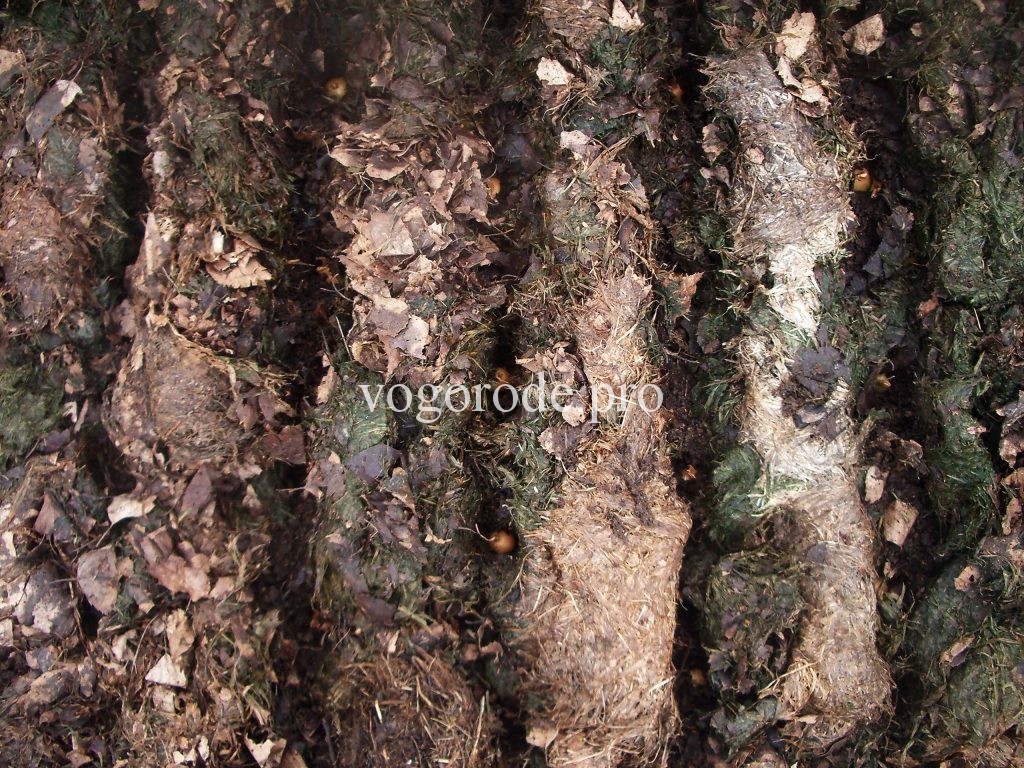
The distance between the grooves and the bulbs is the same, about 10-12 cm. When planting, I try to stick to the chess order.
This distance is quite enough to get bulbs of commercial size.
Bulbs just press into the ground (not in mulch). The mulch at the same time serves as food for soil inhabitants and protects the earth from evaporation of moisture.
For normal growth onions require a lot of moisture. We all know that if you put an onion in a jar of water, the onion will very quickly move into growth and give fresh greens, which is why we press the onion into damp earth.
If you plant a bed before planting, as most gardeners do, then you cannot achieve the desired result. Then the planted sevka will cling the roots to the air in the soil, and not to moisture, and the crop will eventually decrease.
Growing onions on a turnip. Care for onions.
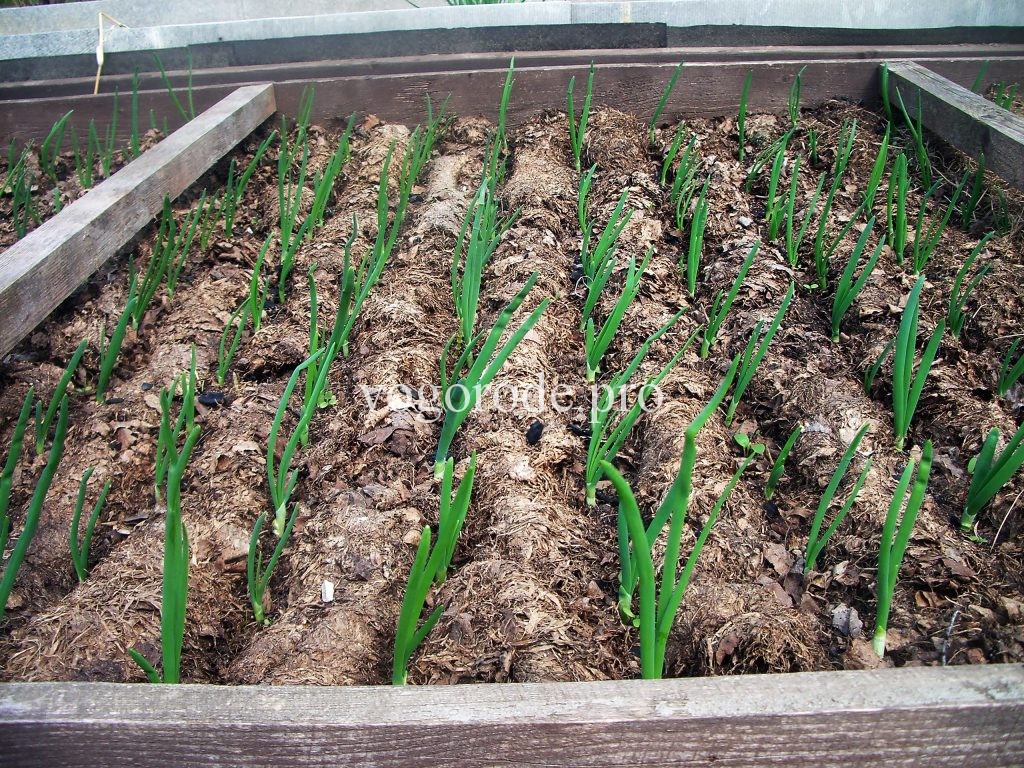 Onions rose quickly and amicably without watering.
Onions rose quickly and amicably without watering. 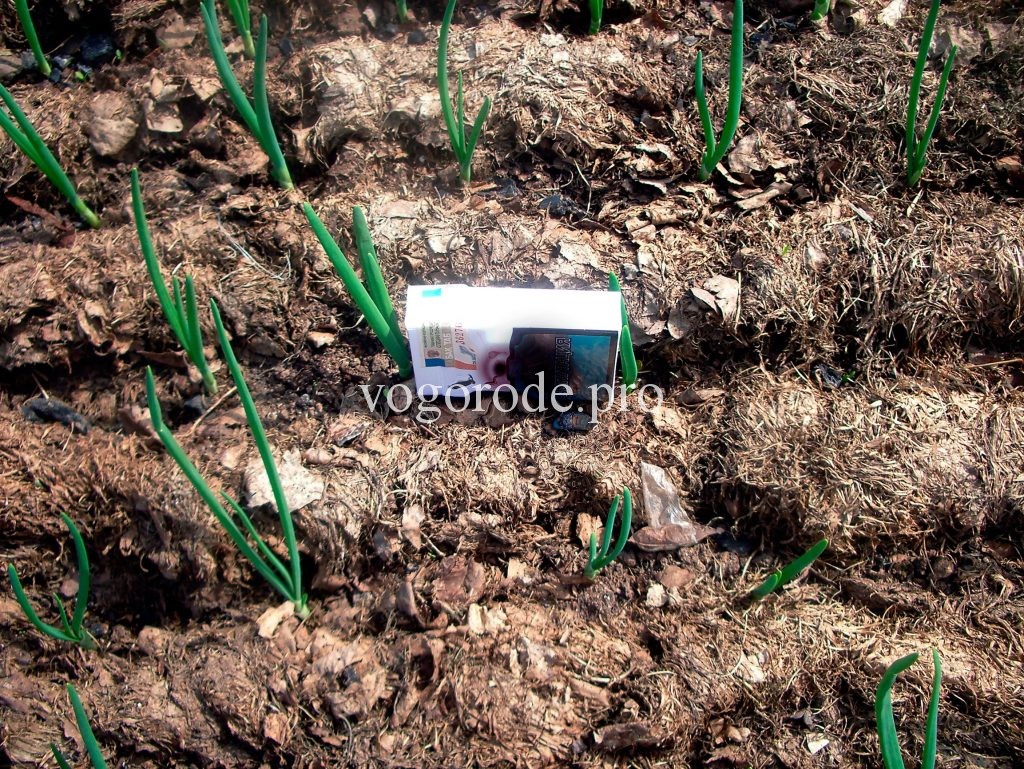 The distance between the grooves and the bulb is the same, about 10-12 cm.
The distance between the grooves and the bulb is the same, about 10-12 cm.
The mulch in the onions has not yet been eaten, the mulch has not decayed, but nevertheless, it is already possible at this stage to mulch the onion with sawdust.
The end of spring and summer were rainy, they poured onions until June 9 only once, and there was not enough time to grind with sawdust.
 All last year’s mulch soil residents have already “eaten”, this year I'm late with mulch sawdust.
All last year’s mulch soil residents have already “eaten”, this year I'm late with mulch sawdust.
This should have been done 2-3 weeks ago.
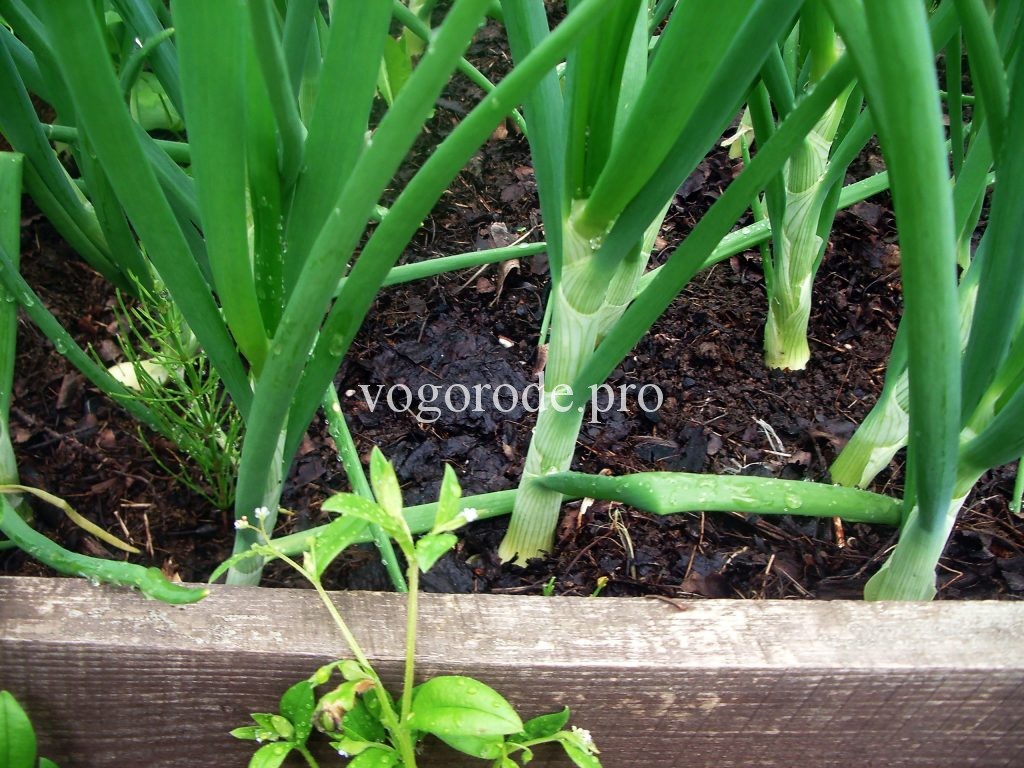 However, the onion feels great, it can be seen in the thickness of the stem.
However, the onion feels great, it can be seen in the thickness of the stem.
Onions are mulched with a layer of 1.5-2 cm. For what?
First, light sawdust protects the ground well from overheating, and, like any other mulch, protects against moisture evaporation. Secondly, I think they are protected from onion flies. At least we never had one. Thirdly, do not allow to grow weeds.
What kind of wood sawdust, I do not know what is on the sawmill, such and use, most likely, coniferous.
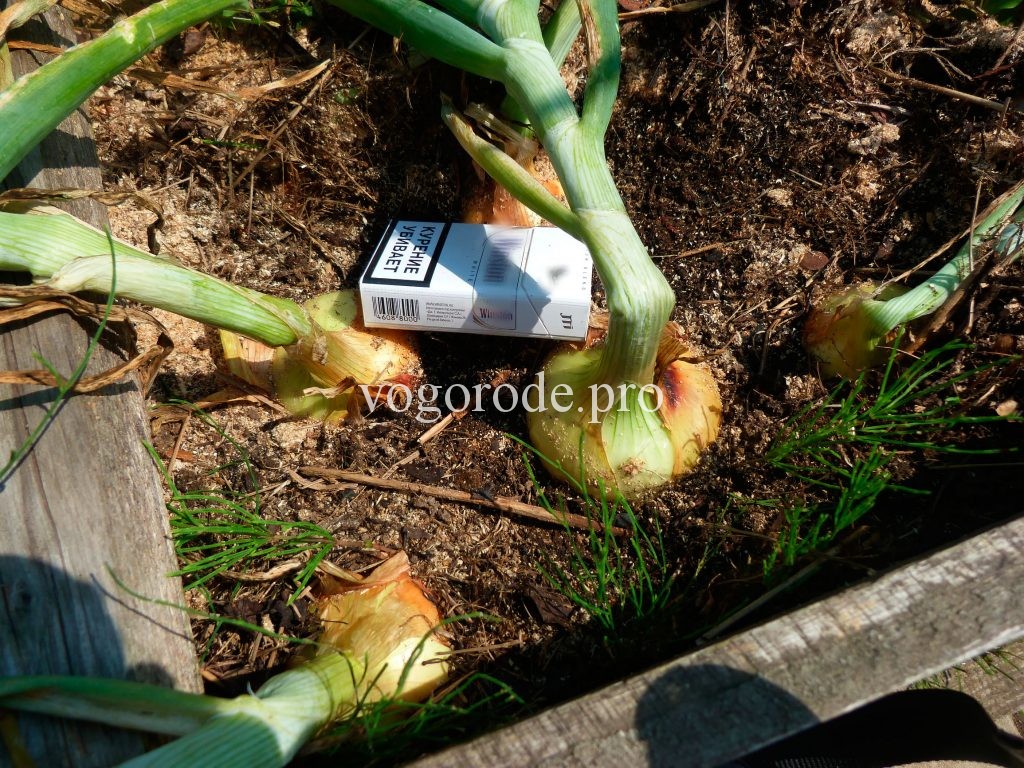 By the time the onions are harvested, there is almost no sawdust, especially if the onions are mulched on time.
By the time the onions are harvested, there is almost no sawdust, especially if the onions are mulched on time.
All care for the onions consisted of two irrigations and one mulching. It was unpleasant that the purchased dog gave a lot of arrows. In other years, this did not happen, I broke off the arrows.
Harvesting onions.
Onion lays down, dries slightly, but not completely - you can remove.
For cleaning it is better to choose sunny weather.
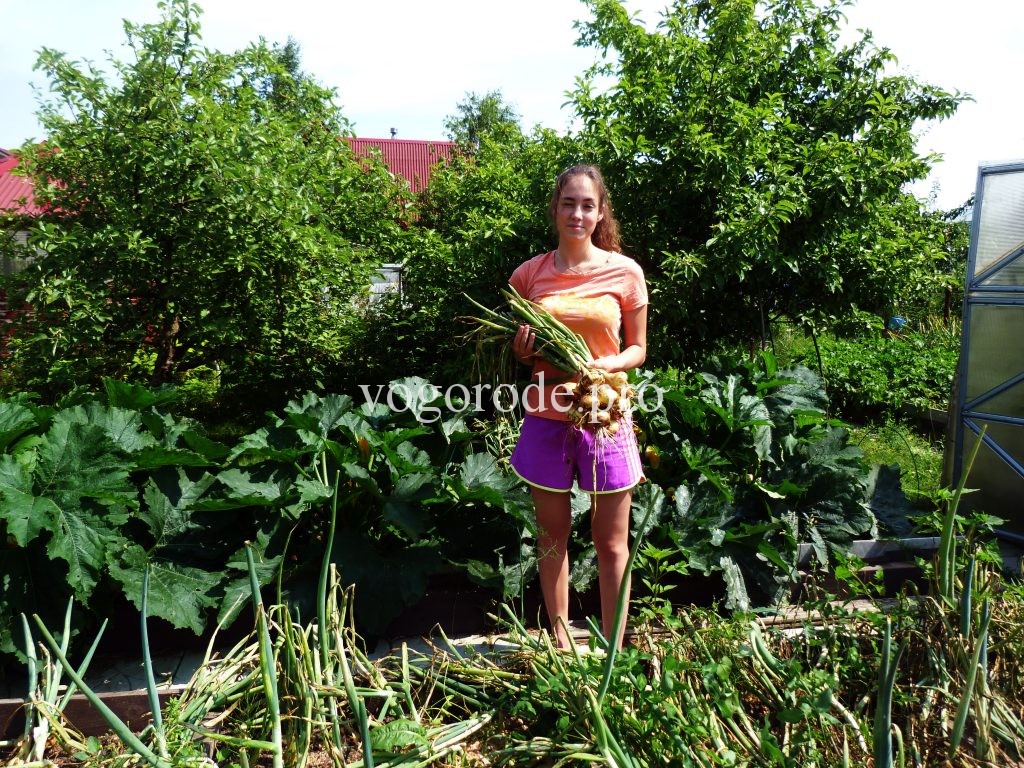
After harvesting the bulbs should lie in the sun, the ground on the roots will quickly dry out and fall off by itself.
Onions grew on a bed of 5 sq.m.
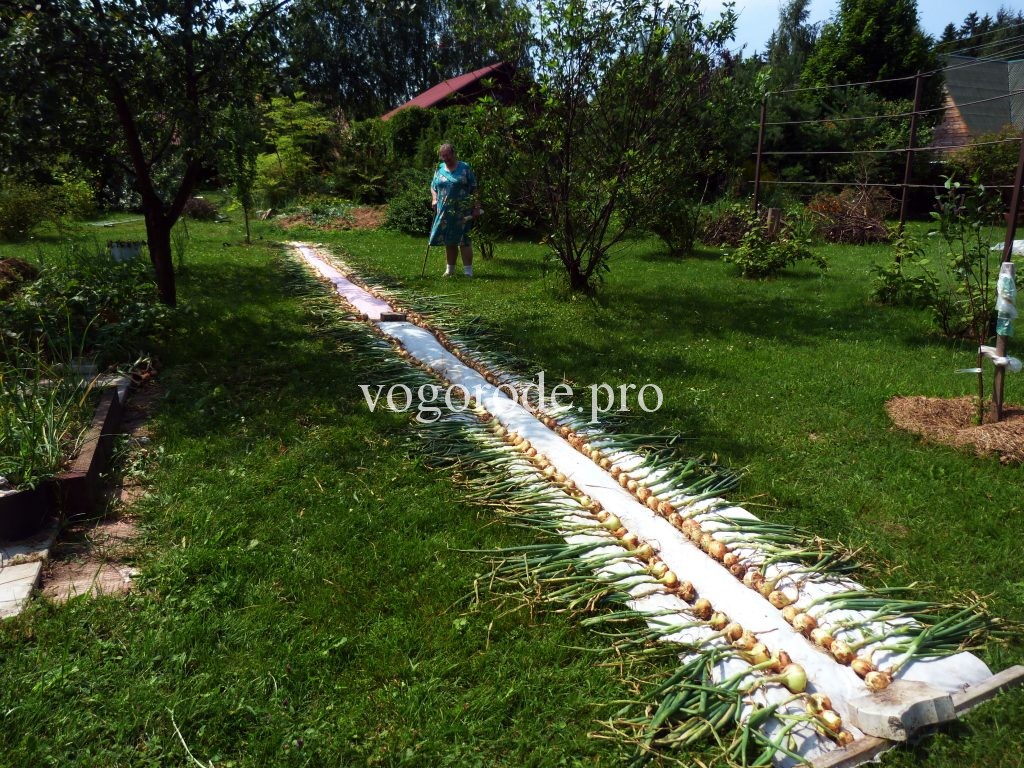
I weighed the onions after it dried, it seemed to me that it would be more honest, it turned out 34.5 kg. Of these, 3 kg of onions, which went to the arrow, these bulbs were immediately used for winter harvesting.
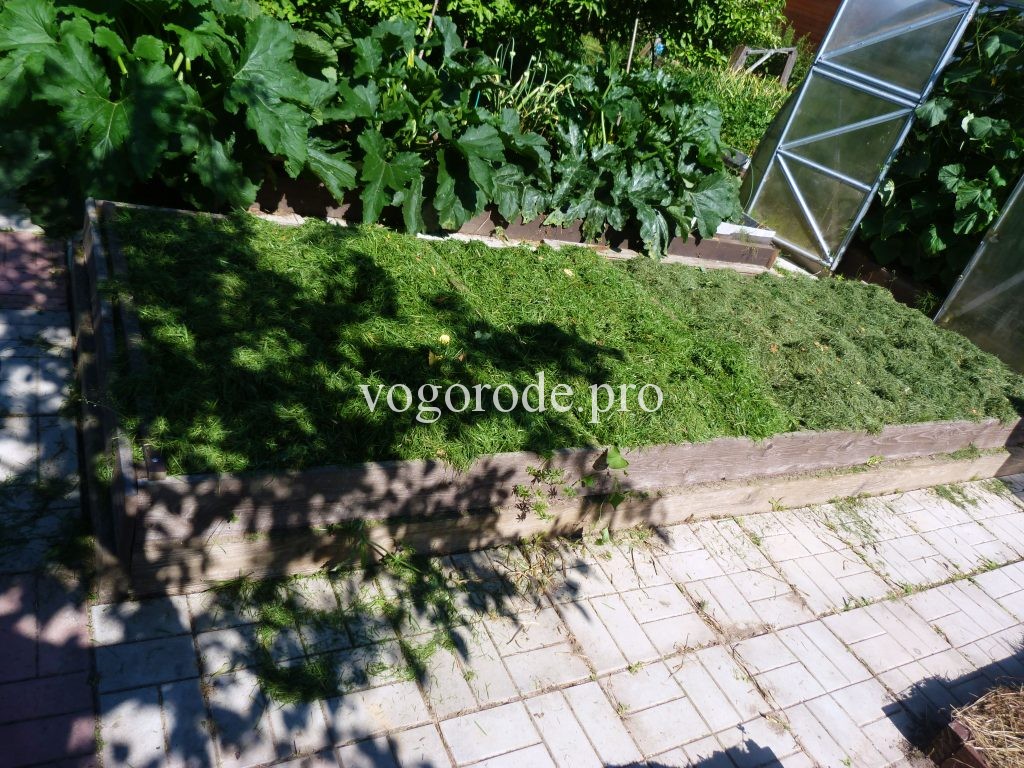 After harvesting the onion, the whole bed is laid with freshly cut grass. Grass layer 25-30cm.
After harvesting the onion, the whole bed is laid with freshly cut grass. Grass layer 25-30cm.
Drying onions.
Onions I dry in greenhouses, in plastic boxes. It is comfortable, the bow dries well. I put a plank on the mulch, and put boxes of onions on them. Between the trunks of peppers, eggplants, tomatoes, there is enough space for a box.
 Drying onions in a greenhouse. In order for the onions to be well kept, they must dry 3 layers of upper flakes.
Drying onions in a greenhouse. In order for the onions to be well kept, they must dry 3 layers of upper flakes. Storage of onions.
Since this onion is grown for food, and not for planting next year, it can be stored both in the apartment and in the country. The temperature, of course, should be above zero.
Strict requirements for the temperature storage of onions exist for sevka and family onions, which will be planted in the spring. Bow for planting should be stored at a temperature above +18 degrees, or at a temperature of +2 +3 degrees. If you store sevok and family bow, which will be landing, at a temperature from + 3 degrees to +18 degrees, then the bow will go to the arrow.
Photo and video. "Cultivation of onions on a turnip from sevka".
Onion plants include such common as onions-batun, bulb onions, and shallots. They are grown for the first spring greens rich in vitamins and phytoncides, as well as bulbs, which are used in the preparation of various dishes and canning. Most onions are unpretentious crops, and even a novice gardener will be able to grow a good harvest with some simple rules.
On one place to grow onion more than 2 years is not recommended. The best predecessors for onions are cucumbers, cabbage, potatoes and legumes. In addition, you can plant onions and garlic after beets, zucchini, squash. Carrots and tomatoes are bad predecessors.
Pests. The main onion pests are onion flies. To combat them, dig up ridges in the fall, on which the onion or garlic grew, before planting, treat the seed material with insecticides, and warm the onion sets for 24 hours at a temperature of + 40-45 degrees. A good result is the use of ash or tobacco dust, if you sprinkle the beds with onion, as well as watering the plants with a solution of water and salt (200 g per bucket of water).
Major diseases. Of the diseases affecting onions, the greatest damage to the crop can cause neck rot, as well as downy mildew. To combat and prevent immediately after harvest, it is recommended to dig up the soil and add slaked lime or ash into it. Damaged plants are recommended to burn.
How to grow onions
Onions - a familiar crop grown for bulbs and feathers (i.e., greens). There are several varieties of onions, which differ in terms of ripening, onion color and taste. A good harvest of this crop can be obtained several times a year: in spring and summer in the garden, in autumn and in winter in greenhouses. A small amount of greenery can be grown even in the apartment on the windowsill.
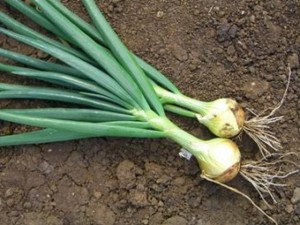
Temperature mode. Onions - quite cold-resistant culture, its seeds germinate well at + 3-5 degrees. And the optimum temperature for growing a plant is 23-25 ° C, hotter weather can negatively affect crop yield.
Landing methods
To produce bulbs, plants are planted in the ground, using seedling and seedless methods, and onions can also be grown from seedlings.
Seedless cultivation. The easiest way of planting onions is seedless. Sow the seeds directly into the ground, plunging them into the soil by 1-1.5 cm (so that the seedlings appear faster soak the seeds).
Onions can be harvested 23-24 weeks after planting, which makes this method of cultivation suitable only for areas with a mild climate in which the planting can be carried out in early spring. In the middle lane, when planted in open ground, onions may not have time to ripen, so in order to get a good harvest, use the subwinter planting or seedling method.
Sub-winter seeding is carried out after the onset of persistent cold so that the onions do not have time to germinate. Prepare the beds in advance, until the soil is frozen. Sow the seeds in the furrows to a depth of 5-6 cm, sprinkle 2-3 cm above with a layer of humus.
Growing onions through seedlings.For strong seedlings, sow seeds in March in shallow boxes or special cassettes. Use for ready-made soil mixtures or fertile garden soil. After sowing, cover the boxes with film and maintain the temperature within 18-25 ° С, when shoots appear, move the boxes to a cool place (10-12 ° С) so that the shoots do not stretch.
After a week, you can raise the temperature by 6-8 ° C. Take shelter for a few hours a day for airing. Water onion seedlings in 2-3 days. You can feed it 1-2 times min. fertilizers (20 g of ammonium nitrate, 15 g of potassium chloride and 40 g of superphosphate per bucket of water).
Planting seedlings in open ground. Before planting seedlings in open ground, it is a good idea to harden it.
Seedlings are best planted in the distance between the rows of 10-12 cm, between plants in a row - 6 cm. In order not to damage the roots of plants when planting, it is best to transplant the onions with a clod of earth. Before planting, pour soil abundantly on previously prepared ridges.
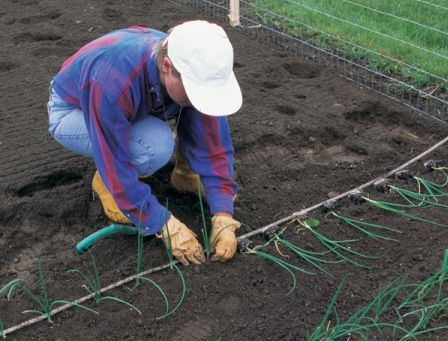
Planting onion seedlings.
The easiest way to plant onions. A less troublesome method of growing onions in areas with a temperate and cool climate is planting a seed (small onions grown from seeds). Landing in the first decade of May, pitting with a scoop or peg and deepening the onions by about 1 cm (try not to sprinkle the neck with earth). Planted sevok at a distance of 20-25 cm between the rows and 5-10 cm between the onions. It is convenient to use a two-row belt landing at a distance of 20-35 cm between the rows and 5-10 cm between the onions.
Indoors, when growing onions on a feather (on greens), use planting as a planting material.
Soil preparation for onion planting
A good harvest can only be obtained by planting in well-lit, sunny areas with rich soil. Onions do not tolerate stagnant moisture, so this culture works best on drained sites. The soil on them should not be clay.
Land for the cultivation of onions is best prepared in the fall. Dig the earth to the depth of the spade bayonet, remove the roots of weeds, apply rotted manure, and mineral fertilizers. In the spring, break the upper layer of soil, then smooth everything with a rake.
How to water
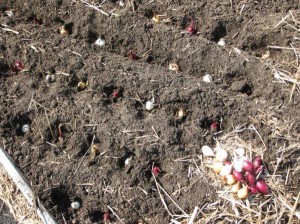
Podzimnaya planting onions.
Onions during the formation and growth of leaves should be watered regularly (in May - once a week, and in June - once in 10 days); between irrigations, loosen the ground between the rows and carefully weed out the weeds. However, remember that a completely different moisture regime is needed for the ripening of the bulbs, therefore, 3-4 weeks before harvesting, completely stop watering.
When growing onions on greens in a protected ground, water the soil as it dries and loosen it in between waterings.
How to feed and fertilize onions
When growing onions in open ground, conduct top-dressings per 1 m2 according to the following scheme: in the fall, when preparing the soil, add 4 kg of compost and 100 g of potassium sulfate; spring before planting - 25 g of nitrogen fertilizers; after the formation of the first leaves - 20 g of nitrogen-phosphate fertilizers, and 5-7 days after that, fertilize the plants with manure diluted in water (in a ratio of 1:10) or bird droppings (in a ratio of 1:20).
To get a good harvest, spend another additional feeding during the formation of the bulbs: apply more phosphate and potash fertilizers at the rate of 15-25 g per 1 m2.
If you notice that the onion grows slowly and its leaves are white, add a mixture of 200 g of mullein and 20 g of urea dissolved in a bucket of water. After 15 days, feed the plants with another solution of nitrophoska.
Onions grown by sowing seeds (chernushka) are fed for the first time in the phase of appearance of the fourth leaf with infusion of mullein (1:10) or chicken manure (1:20), consumption - a bucket of 3-4 square meters. m. Between rows, make grooves 6-8 cm deep, pour them with fertilizer infusion and close up with soil. Two weeks later, a second feeding is carried out: a teaspoonful of urea and potassium sulfate, 2 teaspoons of superphosphate per square meter. m
When growing onions in a pen in the open or closed ground, apply complex fertilizers (1 time in 10 days).
Planting and growing leeks
Leek is a relatively new culture in our country, which is found in vegetable gardens less often than other bulbous ones. This type of onion is more common in the southern regions (this is due to the rather long period from germination to harvesting).
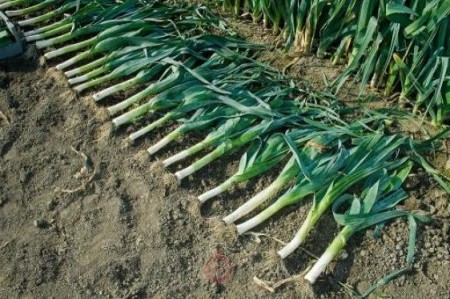
Leek is grown to produce a thickened white base of the stem (this plant does not form bulbs), if desired, you can also use young green leaves for food. The main conditions for obtaining a good harvest of this crop is the correct choice of a site for planting and timely fertilization.
Temperature conditions
To get a good harvest, the average temperature during the growing season should be 17-23 ° C, although in general the crop is cold-resistant and can withstand short-term frosts down to -7 ° C.
When growing leek seedlings, plant the seedlings in the ground when the soil warms up to +10 ° C.
Planting leeks
In the southern regions of our country, leeks can be grown by sowing in open ground, in regions with a cool climate, a seedling method of cultivation is recommended - in this case, you can get a crop in the year of sowing (approximately 45-60 days after planting seedlings in the beds) . The ripening terms depend on the early ripeness of the variety, on the weather conditions and the fulfillment of the agrotechnical requirements.
To speed up the emergence of seedlings, pre-wet the seeds and germinate. Caring for seedlings is about the same as when growing onions: water the seedlings regularly. You can apply liquid complex fertilizers once. The optimum temperature for the growth of leek seedlings is 18–25 ° C before seed germination and 14–16 ° C after germination. If the temperature is higher and the lighting is insufficient, the seedlings will be drawn out.
Planting seedlings in the soil spend in late April or early May. Plant in furrows with a depth of 10-15 cm (the distance between individual plants is not less than 10 cm). After 2 weeks, fill the furrows with fertile soil.
The soil should be fertile and necessarily loose, preferably neutral. On sour soils a good yield of leek will not succeed.
How to water a bow
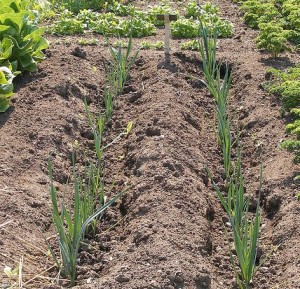
Planting leeks.
The leek plant is moisture-loving, so do not forget to water it regularly from the time the seedlings are planted until the end of the growing season, increasing the frequency of watering in the dry months. After each watering, loosen the row spacing.
Hilling onions
In order to grow juicy bleached stems and high yields, 3-4 times per season, pile up leeks. And of course, apart from this, do not forget to weed out the weeds and loosen the soil.
Top dressing
Regularly feeding leeks - without this, you will not be able to get a good harvest. Especially important for leeks are nitrogen fertilizers - they are especially needed in the second half of summer, when greens are actively formed.
The best will be the alternation of liquid organic fertilizers, for example, an aqueous solution of mullein 1: 8 or bird droppings 1:20 at the rate of 3 liters per 1 square meter. and mineral fertilizers (for example, ammonium nitrate solution and potassium sulfate at the rate of 15-20 g per 1 m2).
Planting and growing shallots
Shallots or family, mnogognezdovy onions, valued for precocity and taste. This species is less common than onions. In one nest several medium-sized bulbs are formed, which have a less pungent taste than regular onions. Shallot can be grown in open ground on the bulbs and feathers, in closed ground - on the feather. The leaves of shallot do not grow coarse for a long time and remain juicy
Temperature conditions
Shallots tolerate low temperatures well. If you leave it to winter, it will easily withstand the freezing of the soil to -20 degrees, and in spring the greens will appear earlier than in other types of onions. The optimum temperature for shallot during the growing season is 20-24 ° C.
Planting shallot onions

Cultivation of shallots.
Shallots are easiest to propagate in a vegetative way - planting bulbs, and for growing new varieties it is preferable to seed propagation.
Bulbs before planting soak for 20-30 minutes in a pale pink solution of potassium permanganate, and then rinse with cold water.
Landings are carried out in the spring (from late April to early May) or in the fall (from late September to early October). For spring planting, use medium bulbs (3-4 cm in diameter), for autumn - smaller ones (about 2 cm in diameter).
Plant the onions to a depth of 2-4 cm, during autumn planting, grind them with peat or ground 3-4 cm.
To obtain large shallot bulbs, experienced gardeners suggest planting in spring, planting onions 15 cm apart, and between rows 30 cm. In the process of growing, periodically tear out one bulb from each nest (they can be used as food) so that by fall 1-2 bulbs left in each nest.
When growing shallot on a feather in a protected ground, plant from the second half of February, then in spring you will harvest the first crop of greenery.
When forcing the shallot on the feather of the bulb, it can be reused. To do this, after cutting the greens, remove them from the soil, cut them across and plant them again in boxes or pots with a fertile soil mixture.
Tillage
When growing shallot onions in the spring in the spring, remove the covering material from the beds as early as possible so that the soil warms up faster. In this case, you will speed up the harvest of greenery.
After the emergence of seedlings, soil the soil between rows and rows, and thoroughly weed.
It is recommended to loosen the aisles 2-3 times over the summer to a depth of 5-6 cm, after each watering it is enough to pierce the earth to a depth of 3-5 cm. During loosening, it is not recommended to pour the soil to the plants themselves, since this slows down the maturation of the bulbs.
If you grow shallots in a greenhouse, loosen the soil not deeply, but after each watering.
Watering
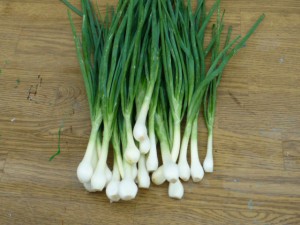
In the first half of the growing season, water shallots regularly: from May to mid-July - 3-4 times a week, in hot and dry weather, you can increase the number of irrigations. In the second half of the summer, you need to water less, and 2-3 weeks before collecting the bulbs you can stop watering.
In shallow water, shallots are watered regularly but moderately. Loosen after each watering.
How to feed shallot
During the entire growing season, it is recommended to feed 1-2 shallots 1-2 times (this is enough to get a rich harvest in both open and in the green field). Use an aqueous solution of mullein (in a ratio of 1:10), bird droppings (in a ratio of 1:15) or complex mines. fertilizers (at the rate of 20 g per 10 l of water).
Planting and cultivation of onions - batuna
Onions - a batun is a perennial plant, it can be grown both in open ground and in greenhouses. At one place the plant can be successfully grown for several years, but in the third year its yield decreases, the leaves become more rough.
In culture, there are several varieties of onion-batun, which can be divided into two main groups. Early ripening peninsula produce harvest in early spring, late ripening sharp ripen 30-40 days later. Growing onion batun is not difficult, especially if you plant varieties that are resistant to diseases.
Temperature conditions
The onion-batun is a winter-hardy culture, it tolerates frosts down to -45 ° С. The optimum temperature for vegetation is 19-23 ° C.
Sowing onions - Batuna

Batun can be propagated by seedling and seedless. Planting seeds in open ground begins at the end of April at a depth of 2 cm. The easiest way is to lower row at 40-50 cm between rows, but you can also use a ribbon sowing scheme: sow seeds 2-5 lines at a distance of 10 cm between rows and as much between plants.
Onions - the batun easily breeds in the vegetative way. To do this, simply divide the bushes and plant each onion separately. It is best to do this in the spring or late summer. Arrange the bulbs in rows.
For a good harvest, plant a bamboos in spring, at least in summer or early autumn.
For distillation in the winter, dig up several plants in the fall and transplant them into boxes, place them in a warm, bright place and water 2-3 times a week.
Early onion harvest
For early greenery in late February - early March, plant a onion-batun in tunnel-type film greenhouses. This method will allow you to get a harvest two or even three weeks earlier (at the same time it will be 1.5-2 times higher than when growing onions in open ground).
You can also use frameless cover: sow the seeds of a batun on the open ground and cover it with a perforated film, sprinkling it along the edges with earth.
For forcing the feather on the bat-onion can be grown in a greenhouse. In the fall, plant delenki in rows, and as early as March, when the leaves of the onion grow 15-20 cm, harvest the first crop.
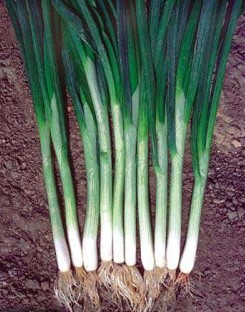
When growing onion batun in the greenhouse, make small furrows on the ridges, plant onions and fill them with soil. To obtain a good harvest, keep the temperature in the greenhouse + 10-15 C, gradually increasing it to 20 C. The optimum humidity of the air is 70-80%. 7-10 days after planting, add mineral fertilizers to the soil.
Loosening
Loosening the row spacing is a guarantee of getting a good harvest of onions. A few days after the first weeding, break the soil between the rows of plants.
Watering
To get fresh juicy greens do not forget to water the onion-batun (with a lack of moisture, its leaves grow coarse and become bitter). The recommended rate is 3-4 times a week for 10-20 l / m2. 3-4 hours after watering, make a row between the rows.
How to feed a bow - batun
To get a good harvest of onions, do not forget to feed him with mullein, diluted 1: 8 or bird droppings (1: 20) just one additional feeding per season. After harvesting, it is desirable to introduce liquid mineral fertilizers (50 g of ammonium nitrate, 3 g of superphosphate and 20 g of potassium chloride per 10 liters of water).

